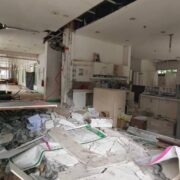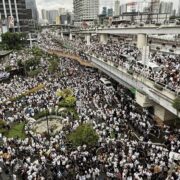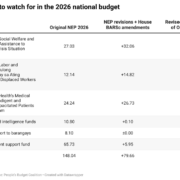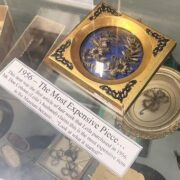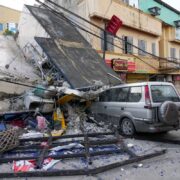SEEKING LUCK, MIRACLES, REDEMPTION: 6M FLOCK TO NAZARENE
By Russel P. Loreto
and Dexter Cabalza
@Team_Inquirer
Gina Catabay, 54, walked barefoot from her home in Quezon City toward Manila, hoping to touch or kiss the Black Nazarene, an icon of a dark-skinned Jesus Christ, as its carriage was pulled through the streets of the capital, in one of the world’s biggest displays of religious devotion.
She was one of an estimated 3.3 million Catholic faithful who celebrated the return of the traditional “traslacion,” or grand procession, on Tuesday, after a three-year hiatus due to the COVID-19 pandemic.
“I’ve walked this path since childhood …. It feels like a conversation with the Divine for my mother’s recovery,” Catabay said.
Like many of her fellow devotees, Catabay was praying for a miracle—that her 87-year-old mother who is battling cancer be healed.
Many Filipinos believe the icon has miraculous healing powers and that touching it, or the ropes attached to its float, can heal incurable ailments and bring good fortune to them and their loved ones.
There were chaotic scenes as the feverish march got underway before dawn following an open-air Mass for the Nazarene statue at Quirino Grandstand.
By 7:45 p.m., the Nazarene procession had completed the six-kilometer journey from the grandstand back to Quiapo Church, taking just shy of 15 hours, the fastest in recent history since the 2020 traslacion, which took 16 hours.
‘Found redemption’
In the evening of Jan. 8, Joselito Flores, 29, who had traveled to Manila from Zambales province, lay down on a pile of carton sheets in front of Quiapo Church, reflecting on his “second chance at life,” which he said he owed to the Nazarene.
“I found redemption in the Black Nazarene. It’s never too late to change,” the former convict said. “I thank the Nazareno because he was the only one that heard my prayers while in prison.”
Philippine National Police spokesperson Col. Jean Fajardo reported no untoward incidents, except mostly minor injuries.
The PNP had deployed a record 18,000 police personnel and 4,000 “force multipliers” to secure the event.
Maj. Gen. Jose Melencio Nartatez, chief of the National Capital Region Police Office and overall security head of Nazarene festivities, said the crowd had reached 3.3 million by Tuesday afternoon.
Crowd control
But estimates by a Church command post placed the total at 6.5 million, with the crowd peaking at 1.4 million in Quiapo district. By Tuesday night, the PNP updated its crowd estimate at 6.1 million.
Security was tight, with the PNP enforcing a “one entry, multiple exits” policy within the general vicinity of Quiapo Church.
On Tuesday morning, devotees continued to gather along Quezon Boulevard, eagerly anticipating the Mass, which was celebrated several times throughout the day and night.
Some hopped over fences and barricades to reach Quiapo Church, also known as the Minor Basilica of the Black Nazarene.
Others knelt in front of the structure and prayed.
Among them was Lester Te, who had brought along his family of four. They had positioned themselves right in front of the church, praying for the family’s health and safety before his upcoming flight to Qatar as a migrant worker.
The carriage carrying the Nazarene image commenced its journey from the grandstand at 4:45 a.m.
A light rain fell at 6 a.m. but this did not deter the arrival of throngs of people. Some barefoot devotees risked injury to reach the float by clambering over others and clinging to the clothes of guards protecting the icon, causing some to fall off the float.
Other guards on the float pushed unruly devotees to the ground to keep them away from the icon enclosed in a glass case.
Pregnant woman
Several people, mostly women, required emergency assistance due to dizziness. Minor scuffles occurred as medical response teams worked to extract them from the crowd.
The humanitarian agency Philippine Red Cross (PRC) said it had attended to more than 600 participants by 4 p.m., most of them for minor complaints.
But there were at least six serious cases, including one who suffered head trauma, PRC said.
Another person had a suspected fracture on the left ankle. Other cases involved severe chest pain, laceration, incision and fainting, it added.
At least 183 people had minor cases of abrasion, infected wound, burn, dizziness, headache, elevated blood pressure, breathing difficulty, chest pain and hyperventilation, PRC said.
At least nine people were transported to the Philippine General Hospital, including a pregnant woman who complained of abdominal pain and a food vendor who suffered second degree burn while cooking.
It was the first time the traditional parade featuring the life-size statue of Christ has been held since 2021, after the pandemic forced officials to drastically downsize the event. —WITH REPORTS FROM AFP, KATHLEEN DE VILLA AND DONA Z. PAZZIBUGAN INQ




